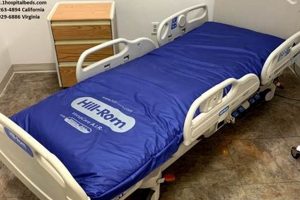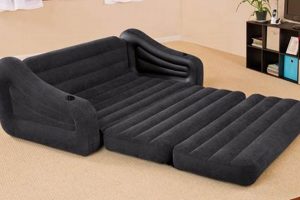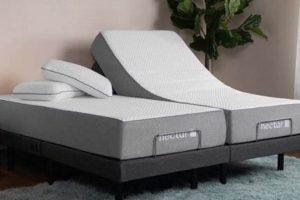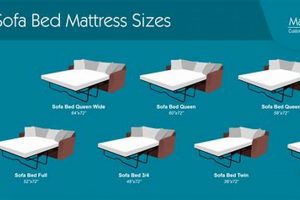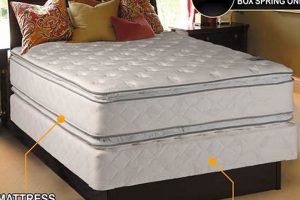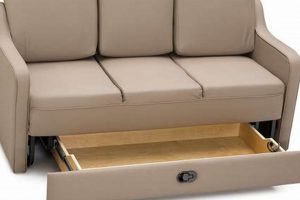A large rectangular sleeping surface, designed to conform to the articulating frame of a motorized bed base, offers expansive space for individuals or couples. This type of bedding configuration allows for customized positioning, elevating the head, feet, or both, to achieve optimal comfort and support.
This setup can be particularly beneficial for individuals seeking relief from back pain, acid reflux, or sleep apnea. The ability to adjust the bed’s incline promotes proper spinal alignment and reduces pressure points, contributing to improved sleep quality and overall well-being. The concept of adaptable bedding systems has evolved from manually adjustable hospital beds to sophisticated, user-friendly home furnishings.
The following sections will delve into the specific considerations for selecting a compatible sleeping surface, the various material options available, and the long-term maintenance requirements for ensuring optimal performance and longevity. This guide also provides insights into factors affecting the investment and maximizing the advantages of the adjustable base.
Guidance for Optimal Selection
The following recommendations provide crucial information for those considering a bedding solution designed for use with an adjustable bed frame. Proper selection ensures both comfort and longevity of the components.
Tip 1: Assess Flexibility. Ensure the selected sleeping surface demonstrates adequate flexibility to conform to the adjustable base’s articulation. Rigidity can lead to material damage and discomfort.
Tip 2: Consider Material Composition. Memory foam and latex constructions generally offer superior adaptability compared to traditional innerspring models. Hybrid options may provide a balance of support and flexibility.
Tip 3: Evaluate Thickness. Excessive thickness can impede the base’s ability to effectively contour. Consult the adjustable base manufacturer’s guidelines for recommended mattress height.
Tip 4: Prioritize Edge Support. Adequate edge support prevents sagging and facilitates ease of entry and exit from the bed, especially important for individuals with mobility limitations.
Tip 5: Examine Weight Considerations. Confirm that the chosen sleeping surface’s weight does not exceed the adjustable base’s weight capacity. Overloading can compromise the motor and structural integrity.
Tip 6: Review Warranty Specifications. Carefully review warranty terms, paying close attention to stipulations regarding use with adjustable bed frames. Some warranties may be voided by improper pairings.
Tip 7: Inspect Motion Isolation. Given the shared sleeping surface, motion isolation properties are essential to minimize disturbance from a partner’s movements, especially as the bed’s position changes.
Adhering to these guidelines facilitates a more comfortable and supportive sleep experience, extending the lifespan of both the bed base and its corresponding sleeping surface. The subsequent sections will cover specific considerations for long-term maintenance and potential troubleshooting.
1. Flexibility
Flexibility is paramount when selecting a sleeping surface for an adjustable bed frame. The capacity to conform to the articulating sections of the base is not merely a matter of comfort but a fundamental requirement for the longevity and proper function of both the bed and the sleeping surface.
- Conformity to Articulation
The primary function of a mattress designed for an adjustable base is to mirror the various positions the base assumes. Without sufficient give, the material will resist the adjusted contours, potentially leading to increased pressure points on the sleeper’s body. A lack of conformity can also cause the base’s motors to work harder, shortening their lifespan.
- Material Stress and Durability
Inflexible materials are susceptible to damage when repeatedly bent or compressed at unnatural angles. Stress fractures, tears, and delamination can occur, significantly reducing the lifespan of the sleeping surface. Choosing materials known for their elastic properties, such as memory foam or latex, minimizes the risk of such damage.
- Impact on Support and Alignment
A rigid sleeping surface hinders the benefits of an adjustable base by negating the intended support and alignment. When the head or feet are elevated, an inflexible sleeping surface may create a hammock effect, causing the spine to curve unnaturally. This can exacerbate back pain and negate the ergonomic advantages of the adjustable system.
- Compatibility with Base Mechanisms
The design of the adjustable base incorporates hinges and pivot points to facilitate smooth and quiet transitions between positions. An incompatible, inflexible sleeping surface can interfere with these mechanisms, causing undue stress on the base’s frame and motor. This can lead to operational failures or premature wear.
The consideration of flexibility in the context of an adjustable bed is thus not optional but an integral aspect of ensuring a comfortable, supportive, and durable sleep system. Failure to prioritize this characteristic can result in compromised sleep quality, premature wear of equipment, and an overall diminished return on investment. Choosing an appropriate sleeping surface is critical to the functionality and longevity of the adjustable bed system.
2. Material Compatibility
Material compatibility is a critical determinant in the performance and longevity of a sleeping surface designed for adjustable bed frames. The chosen material must withstand the stresses induced by frequent articulation and provide adequate support and comfort across various positions.
- Memory Foam Considerations
Memory foam excels in conforming to the contours of an adjustable base due to its viscoelastic properties. However, density variations significantly impact performance. Higher-density memory foam provides superior support but may exhibit reduced flexibility, potentially hindering articulation. Conversely, lower-density options offer greater flexibility but may lack adequate support for heavier individuals, leading to premature sagging and reduced comfort. Selecting a memory foam with a balanced density is paramount.
- Latex Suitability
Latex, both natural and synthetic, presents a viable alternative to memory foam. Natural latex, known for its resilience and durability, provides excellent support while maintaining flexibility. Synthetic latex, often more affordable, may exhibit lower durability and reduced elasticity. Dunlop latex, a denser variety, offers firmer support, while Talalay latex is softer and more responsive. The choice between Dunl
op and Talalay depends on individual preferences for firmness and support. - Innerspring Limitations
Traditional innerspring mattresses generally exhibit limited compatibility with adjustable bases. The interconnected coil systems restrict flexibility and can lead to uneven support and discomfort when the base is articulated. While some innerspring models incorporate individually wrapped coils to enhance flexibility, their overall adaptability remains inferior to memory foam and latex options. Innerspring designs may also place undue stress on the base’s mechanisms, potentially reducing its lifespan.
- Hybrid Construction Implications
Hybrid mattresses, combining innerspring cores with layers of memory foam or latex, aim to balance support and flexibility. However, the performance of hybrid models hinges on the gauge and configuration of the coils, as well as the thickness and density of the comfort layers. A poorly designed hybrid may exhibit the limitations of both innerspring and memory foam/latex, resulting in compromised comfort and durability. Careful evaluation of the coil system and comfort layer composition is essential.
Ultimately, material compatibility directly impacts the functionality and lifespan of an adjustable bed system. Selecting materials that balance flexibility, support, and durability is crucial for maximizing the benefits of the adjustable base and ensuring a comfortable and restorative sleep experience. Careful consideration of these factors can mitigate potential issues and enhance overall satisfaction with the bedding system.
3. Thickness
Thickness is a critical parameter in the context of a king size mattress for an adjustable bed, significantly impacting both comfort and functionality. Its influence extends to articulation capability, support characteristics, and overall compatibility with the bed frame’s mechanics.
- Articulation Interference
Excessive mattress thickness can impede the adjustable bed frame’s articulation. A thicker mattress requires more force to bend and conform to the base’s positions, potentially straining the motor and reducing the range of motion. This limitation can negate the benefits of the adjustable frame by preventing the sleeper from achieving desired ergonomic positions. Conversely, a mattress that is too thin may lack sufficient cushioning, leading to discomfort and inadequate pressure relief.
- Support and Spinal Alignment
Thickness plays a crucial role in the support provided by the sleeping surface. An insufficient profile may not offer adequate support for heavier individuals, leading to spinal misalignment and discomfort. A balance must be struck to ensure sufficient cushioning and support without compromising the articulation capabilities of the base. The internal structure of the mattress, in conjunction with its overall thickness, dictates its ability to maintain proper spinal alignment in various inclined positions.
- Weight Distribution and Base Capacity
The combined weight of the mattress and occupants must remain within the adjustable bed frame’s specified weight capacity. A thicker mattress generally weighs more, potentially exceeding the limit and causing operational issues or structural damage to the base. Careful consideration of the weight-to-thickness ratio is necessary to ensure the system operates within its design parameters. Exceeding the weight limit can also void warranty coverage.
- Edge Support Degradation
Thickness influences the effectiveness of edge support features. A thicker mattress, without adequate edge reinforcement, may exhibit increased edge sagging, particularly when the bed is in an inclined position. This can compromise the usable sleeping surface area and make it more difficult to enter or exit the bed. Manufacturers often integrate reinforced edges to mitigate this issue, but the overall mattress thickness remains a contributing factor.
The relationship between mattress thickness and adjustable bed functionality is multifaceted. Selecting a king size mattress with appropriate thickness, considering articulation, support, weight distribution, and edge support, is essential for optimizing the comfort and performance of the entire sleep system. The manufacturer’s recommendations for both the mattress and the adjustable base should be carefully considered to ensure compatibility and longevity.
4. Edge Support
Edge support is a critical characteristic, particularly when selecting a king size mattress for an adjustable bed. While often overlooked, robust edge support contributes significantly to the functionality, comfort, and longevity of the sleep system, especially given the dynamic nature of an adjustable base.
- Stability During Articulation
An adjustable bed inherently alters the mattress’s geometry. Without sufficient edge support, the perimeter of the mattress may sag or deform when the head or foot sections are elevated. This compromises the usable sleeping surface and can create an unstable feeling, particularly when near the edge of the bed. Reinforced edges mitigate this effect, maintaining a consistent surface even during articulation.
- Facilitating Ease of Entry and Exit
The robust perimeter provided by strong edge support simplifies getting into and out of the bed. The solid edge acts as a stable platform, reducing the effort required to transition between a seated and lying position. This is especially relevant for individuals with mobility limitations or those recovering from injuries who may rely on the edge of the bed for support.
- Maximizing Usable Sleeping Surface
Edge support directly impacts the available sleeping area. A mattress with weak edges will compress significantly under weight, effectively reducing the usable width. This is particularly noticeable on a king size mattress shared by two individuals. Strong edge support prevents this compression, ensuring that the entire surface area can be utilized comfortably.
- Preventing Roll-Off and Motion Transfer
Effective edge support minimizes the sensation of rolling off the bed, particularly near the perimeter. It also contributes to motion isolation by dampening vibrations and preventing them from propagating across the sleeping surface. This is advantageous for couples sharing a bed, as it reduces the likelihood of disturbing a partner’s sleep when adjusting positions or moving around.
Considering edge support is integral to selecting a suitable king size mattress for an adjustable bed. The benefits extend beyond simple comfort, influencing stability, ease of use, and the overall lifespan of the mattress. By prioritizing this feature, users can optimize their sleep experience and maximize the functionality of their adjustable bed system.
5. Weight Capacity
The weight capacity of an adjustable bed frame is a crucial specification that directly impacts the selection of a compatible king size mattress. Adjustable bed frames are engineered to support a maximum weight, encompassing the combined mass
of the mattress and the occupants. Exceeding this limit can lead to mechanical failure, reduced functionality, and potential safety hazards. For example, overloading the frame can damage the lifting mechanisms, resulting in an inability to adjust the bed’s position or complete motor burnout. The frame’s structural integrity may also be compromised, leading to bending or breakage of components.
Selecting a king size mattress requires careful attention to its weight, as these larger mattresses are inherently heavier than their smaller counterparts. A high-density memory foam mattress, for instance, will weigh significantly more than a thinner, less dense innerspring model. It is imperative to consult the adjustable bed frame’s documentation to determine its maximum weight capacity and then select a mattress that, when combined with the weight of the intended occupants, remains within that specified limit. Failure to adhere to these weight restrictions can void the warranty and result in costly repairs or replacements. In a real-world scenario, a couple exceeding the bed’s weight capacity may experience a gradual decline in the frame’s performance, culminating in complete failure of the adjustment mechanisms.
In summary, the weight capacity of the adjustable bed frame is a primary constraint when choosing a king size mattress. Understanding the interplay between mattress weight, occupant weight, and the frame’s limitations is essential for ensuring safe operation, preserving the system’s longevity, and maximizing the benefits of an adjustable bed. Neglecting this consideration can lead to mechanical failure, warranty invalidation, and potential safety risks. Therefore, thorough research and adherence to manufacturer specifications are paramount.
6. Warranty
The warranty associated with a king size mattress intended for use on an adjustable bed is a crucial factor determining the long-term value and protection of the consumer’s investment. A standard mattress warranty may be voided if the mattress is used on an incompatible adjustable base, specifically one that does not provide adequate support or that places undue stress on the internal components of the sleeping surface. Therefore, confirming that the manufacturer specifically warrants the mattress for use with an adjustable bed frame is paramount. A lack of such explicit coverage exposes the consumer to potential expenses arising from premature sagging, structural damage, or coil failure attributable to the flexing and contouring inherent in adjustable bed operation. For instance, if a mattress designed solely for a flat foundation experiences spring breakdown due to repeated articulation, the warranty claim may be denied.
The warranty’s fine print often dictates specific conditions under which coverage remains valid. These may include stipulations regarding the type of adjustable base deemed acceptable, the maximum degree of articulation permitted, or the level of support provided across the sleeping surface. A common clause excludes coverage for damage resulting from “misuse,” and the use of an incompatible adjustable base may be interpreted as such. Furthermore, some warranties impose weight restrictions, and exceeding the specified limits can invalidate the coverage, regardless of the base’s compatibility. It is therefore essential to scrutinize the warranty document to ensure full comprehension of the terms and conditions applicable to adjustable bed usage. Failing to do so can result in unexpected out-of-pocket expenses for repairs or replacements.
In summary, the warranty constitutes a critical component of the purchasing decision for a king size mattress intended for an adjustable bed. Explicit confirmation of adjustable bed compatibility, careful review of the warranty’s terms and conditions, and adherence to weight restrictions are essential steps in protecting the consumer’s investment. A comprehensive understanding of the warranty mitigates the risk of claim denials and ensures long-term peace of mind regarding the durability and performance of the sleeping surface. Without diligent consideration, the consumer risks assuming full financial responsibility for defects or damage attributable to the unique demands of an adjustable bed frame.
Frequently Asked Questions
The following addresses common inquiries regarding selecting and maintaining a king size mattress intended for use with an adjustable bed frame. The information provided aims to clarify key considerations and dispel potential misconceptions.
Question 1: What types of mattresses are generally suitable for adjustable beds?
Memory foam, latex, and certain hybrid models are typically recommended. These materials possess the flexibility required to conform to the articulating frame without sustaining damage or compromising comfort. Traditional innerspring mattresses often lack sufficient flexibility.
Question 2: Will using a non-compatible mattress damage an adjustable bed frame?
Potentially. A mattress lacking adequate flexibility can place undue stress on the frame’s motors and hinges, leading to premature wear or mechanical failure. It may also impede the frame’s ability to achieve its full range of motion.
Question 3: How does mattress thickness affect the performance of an adjustable bed?
Excessive mattress thickness can hinder articulation and reduce the range of motion. A mattress that is too thin may not provide adequate support. The ideal thickness depends on the frame’s design and the individual’s comfort preferences.
Question 4: Is edge support important for mattresses used on adjustable beds?
Yes. Strong edge support provides stability and prevents sagging, particularly when the bed is in an elevated position. It also facilitates ease of entry and exit.
Question 5: Does mattress weight affect the adjustable bed’s functionality?
Yes. Adjustable bed frames have weight capacity limits. Exceeding this limit can damage the frame’s mechanisms and void the warranty. The combined weight of the mattress and occupants must remain within the specified range.
Question 6: Are there specific warranty considerations for mattresses used on adjustable beds?
Indeed. Standard mattress warranties may be voided if the mattress is used on an incompatible adjustable base. Confirm that the warranty explicitly covers use with adjustable beds and understand any specific limitations or requirements.
Selecting a compatible king size mattress involves careful evaluation of material composition, thickness, edge support, weight, and warranty provisions. Failure to address these factors can compromise both comfort and the long-term performance of the adjustable bed system.
The subsequent section will provide guidance on selecting the ideal foundation or base.
King Size Mattress for Adjustable Bed
The preceding analysis has underscored the multifaceted considerations inherent in selecting a sleeping surface for adjustable bed frames. Key factors, including material compatibility, thickness, edge support, weight capacity, and warranty implications, demand careful evaluation. Optimal performance and longevity of the entire system hinge on informed decision-making. The adaptability of memory foam and latex, coupled with stringent adherence to weight restrictions and warranty specifications, emerge as critical determinants.
Prospective purchasers should diligently assess individual needs and meticulously review manufacturer guidelines to ensure complete compatibility. The integration of a king size mattress with an
adjustable bed represents a significant investment in sleep quality and overall well-being; therefore, a comprehensive understanding of the selection criteria is paramount. Continued research and adherence to established best practices will further enhance the long-term benefits derived from this advanced sleep technology.


